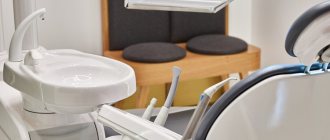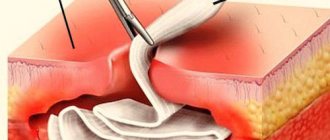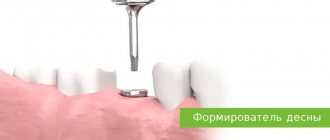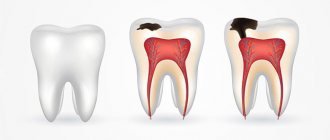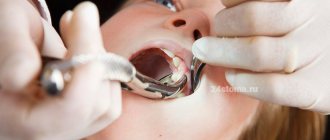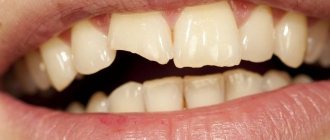What are crown + root modules?
Previously, in the case of complete destruction of the front tooth, but with the presence of a healthy root, the crown was attached to a pin - now pins are a thing of the past and are replaced by a single CEREC module “crown + root”
When restoring three or four consecutive front teeth, we can recommend the installation of a bridge-like orthopedic structure - a fused connection of several crowns. But many patients choose separate crowns for each tooth, which are not only more practical, but also look more aesthetically pleasing.
What are the features of prosthetics for anterior teeth?
Any specialist understands perfectly well how important his smile is for a person, because it is a kind of business card, which means it is the first thing we pay attention to when meeting or getting to know each other. A lot depends on its beauty: the success of the transaction, personal relationships and - most importantly - the psychological state of its owner. Therefore, every time doctors are faced with the need to restore a front tooth, they are faced with an important and difficult task: to quickly and efficiently carry out the procedure. Prosthetics of the front tooth requires not only the correct recreation of the function, shape and color of the tooth, but also requires paying special attention to the “pink aesthetics”, that is, the gum.
Tooth loss: causes and methods of restoration
The method of restoration will be determined by why the tooth fell out.
Advanced caries or pulpitis. With insufficient hygiene and lack of treatment for caries, it turns into pulpitis, and hard tissues begin to collapse. The process is very painful, accompanied by inflammation, the crown gradually cracks, and the infection spreads to the pulp and root. When a tooth falls out, it feels like a relief: it will finally stop hurting. In practice this is almost always not the case:
- inflammation can affect periodontal tissue. Without treatment, the infection will continue to spread, affect surrounding tissues, and provoke new complications;
- Teeth destroyed by pulpitis do not always fall out completely. Collapse of the crown walls may occur, leaving the infected root in place.
Even if the pain goes away after a loss, this does not mean that the problem is solved. The absence of pain indicates the death of the nerve. It is accompanied by necrosis, which provokes the appearance of new foci of inflammation.
What to do: You need to see a doctor as soon as possible. It is better not to wait until the crown is completely destroyed. If it remains above the gingival margin, there is a chance to preserve the living root and perform restoration or prosthetics. If the crown is completely destroyed, the doctor will remove the remaining root and begin preparation for prosthetics. When the crown is destroyed by caries or pulpitis, diagnostics is needed: the dentist must evaluate the condition of the root, periodontal tissues, and nerves in order to prevent the development of inflammation and complications.
Periodontitis or periodontal disease. This is gum disease. They have different courses, but the result is the same: teeth become loose and fall out. However, they can be quite healthy. The problem is the condition of the gum tissue. Long before the loss, symptoms should appear: loosening, drooping of the gingival margin (tooth enamel is exposed), possible bleeding of the gums, itching, discomfort, and pain. If a tooth has already fallen out due to gum disease, the doctor must evaluate the condition of the gum and bone tissue in order to offer the patient implantation or prosthetics.
What to do: it is better to consult a dentist when the first symptoms appear (the gums begin to bleed, its edges droop, itching appears, a reaction to temperature stimuli). If the patient has not done this, more complex treatment will be needed. The periodontist must restore the normal state of the gums (relieve inflammation, normalize blood circulation, etc.). If such treatment is possible, implantation is performed next. If not, a removable or bridge prosthesis is installed.
Injury. A lost tooth may be healthy and your gums may be in normal condition. The recovery tactics will be determined by how exactly the crown was damaged and whether the root was preserved.
What to do: You need to urgently consult a dentist. If possible, a fallen crown should be preserved. If a patient breaks and swallows a tooth (or loses it or throws it away), prosthetics will be needed to restore the dentition. If a tooth falls out completely and is preserved, there is a chance that it can be returned to its place (it is placed in the hole and secured with a splint).
If a tooth is completely knocked out, you need to:
- stop bleeding in the hole (press with a sterile swab);
- quickly find the tooth, do not touch the root, grab only the crown;
- rinse it carefully in water (do not wipe it, do not wash it under running water);
- put in place (in the hole), fix (bite through gauze or tampon);
- contact your dentist immediately.
Healing is possible if the tooth can be returned to its place (put in the hole) half an hour (before the nerve dies). If you can’t do this yourself, it is placed in whole milk (not water) and delivered to the dentist. It is impossible to leave the tooth dry (not in milk), the nerve will die in a few minutes.
Prosthetics, implantation, restoration.
Leave a request, we will call you back within 5 minutes
+7
In what cases are veneers used to restore front teeth?
If the problem is minor damage in the area of the front teeth, such as cracks or minor chips, as well as in cases where a person is not satisfied with the shape and color of the front teeth, it is advisable to correct the defect by installing ceramic veneers. A veneer is a thin porcelain plate no more than 0.3 mm wide, which is fixed to a ground tooth using composite cement. Modern materials from which veneers are made are very durable, hypoallergenic and can imitate almost all shades of natural enamel, as well as its transparency. Many modern dental clinics in Moscow, which provide prosthetics for front teeth using this orthopedic design, can offer the installation of veneers during one visit to the doctor. With careful care, such ceramic restorations will serve their owner for at least ten years.
Indications and contraindications
Bone tissue is formed in girls up to eighteen years old, and in boys up to twenty-one years old. Therefore, the installation of pins during this period is strictly prohibited. There is no upper age limit for the procedure.
In case of blood clotting disorders, as well as regeneration of soft and hard tissues, this surgical intervention can become critical for life. People with an unbalanced psyche or pregnant women are also not allowed to undergo the procedure.
In other cases, nothing limits the patient. However, it should be remembered: this manipulation must be performed by a qualified specialist after a mandatory preliminary examination.
Indications for use are:
- complete or partial loss of supporting elements of the jaw, on which removable dentures can be attached;
- allergic reactions to materials;
- inability to use alternative options for other reasons.
What are Lumineers and when are they used?
Lumineers are another type of orthopedic plates designed primarily to correct the color and shape of the tooth surface. The installation of lumineers, unlike veneers, is carried out in one visit and does not involve grinding of the dentition. That is why there is no need to wear temporary structures before installing them. Lumineers also have an undeniable advantage over composite restorations: thin ceramic plates do not darken over time.
However, there are also disadvantages. Since lumineers are installed on an unground surface, it is sometimes very difficult to achieve a tight fit to the teeth. In addition, the tooth on which the lumineer is attached differs from the natural dentition in size and shape, so it is not recommended to correct local defects with its help.
Stages of prosthetics of anterior teeth with metal-ceramics:
- Initial consultation
and measures for hardware examination of the problem area - after a visual examination, an overview image of the jaw and computed tomography are taken to identify pathologies. - Therapeutic stage
– a plan of measures for prosthetics is developed based on the results of the diagnostics. The therapeutic plan takes into account not only the process of installing the prosthesis itself, but also additional procedures, for example, treatment of caries, pulp, sanitation of the oral cavity, and even removal of severely inflamed teeth. - The preparatory stage
- prosthetics of single-rooted teeth involves mandatory depulpation. Since the risk of getting a burn when preparing an abutment tooth is quite high. Then the canals are cleaned and sealed with a special compound. An impression of the turned unit is made, the impression is sent to the laboratory, where a frame will be made from it. - Frame fitting
– after one to two weeks, the patient is fitted with the base of the future crown. If necessary, the shape of the “cap” is adjusted for a better fit and sent back to the dental technician to apply the required layer of ceramics to the base. - Fixation
– the finished crown on the front tooth is installed on a prepared support.
In order to improve aesthetics, when installing crowns on the front teeth, the ceramic coating is made with a bend at the base to avoid the appearance of dark arches between the prosthesis and the gum.
In case of severe carious tooth decay, it is not enough to just fill the root canal. To prevent a crown placed on a front tooth from becoming loose over time and then simply falling out along with the filling, it needs additional fixation.
How is prosthetics performed for severely damaged front teeth?
Modern prosthetics of anterior teeth in many cases involves the use of an old proven method - installing a crown. This prosthesis is a protective frame that is put on the ground remaining part of the tooth and completely repeats the shape and color of the lost crown part. The need to use this orthopedic design arises in cases where the tooth is destroyed by more than 50%. Before installing it, the doctor grinds down the tooth (what’s left of it), and only then puts on the “cap,” that is, the crown itself. Modern specialists prefer to prosthetize the front teeth using the most aesthetic type of crowns on a frame made of lithium disilicate, feldspathic ceramics and zirconium dioxide.
Which crowns to choose
Ceramic crowns are most often used to replace lower or upper front teeth. They are completely indistinguishable from real teeth. Ceramic crowns transmit and refract light, just like natural enamel, which is why they look so natural. In second place in popularity is zirconium dioxide. Typically, this material is used to create the base of the crown, which is covered with layers of ceramic on top. Zirconium dioxide structures are almost as aesthetically pleasing as ceramic ones. Both crown options allow you to keep your smile beautiful and natural.
How are missing or severely damaged teeth restored?
Dental implantation is considered the most reliable and optimal option for restoring missing or unrecoverable incisors. Implants do not require grinding of adjacent teeth, and their installation has virtually no contraindications. Implantation is considered the best option for prosthetic treatment of anterior teeth for periodontitis. When reconstructing teeth in the anterior region, specialists prefer to work using an accelerated method, that is, to carry out one-stage implantation. It makes it possible to completely restore a tooth in one visit to the doctor and maintain the correct contour and volume of the gums. The patient is given an implant, and immediately after that a temporary crown is installed, which completely restores the aesthetics of the smile. However, it must be remembered that one-stage implantation is possible only under certain conditions. Otherwise, if for some reason it is impossible to immediately install a temporary crown, the doctor still does not let the patient go “with a hole instead of a tooth,” but temporarily covers it with a removable denture.
Calculation of dental implants for implantation: how they fit in
For each specific case, the doctor determines the amount individually. It depends on the structural features of the oral cavity, the volume of soft tissues, and other indications. Please note that only a qualified specialist can correctly calculate the chewing load.
The general practice is to start with ten pins in each jaw if the patient is completely edentulous. If the installation position is correctly calculated, a good result can be obtained using six or eight support elements.
Installing many implants is expensive. Therefore, people with limited income strive to reduce their number. A properly made prosthesis will distribute the load evenly. But, in this matter, it is recommended to exercise healthy wisdom and choose the best option, based on the recommendations of a specialist.
The next question that is often asked in the dentist’s chair is: what material should the pin be made of? There are many elements used in this field, therefore, only a qualified specialist can determine the appropriate ones based on contraindications.
A competent doctor will offer several options to choose from that can solve the problem, so that the patient can independently choose the one that is suitable for the price.
Prevention of periodontitis
To prevent periodontitis, the patient is recommended to undergo professional teeth cleaning twice a year. If plaque forms on your teeth quickly, or you have problems with self-hygiene, then it is better to visit a hygienist more often, this will preserve the health of both your teeth and gums. Read more about prevention and hygiene measures here.
The patient took a break for some time to prepare financially for further treatment. Doctors did everything to maintain the health of the dental system while waiting.
Dial-Dent specialists who took part in this treatment
- Orthopedic dentist S.V. Zukor – diagnostics, treatment planning, preparation of treatment estimates.
- Surgeon T.R. Zhazykoev – tooth extraction under sedation.
- Anesthesiologist V.S. Kulakov – conducting sedation, monitoring the patient’s condition.
- Dentist-endodontist Yu.A. Borisova – treatment of dental canals under a microscope.
- Dental hygienist E. Smirnova – professional oral hygiene, preparation for dental treatment, selection of hygiene products, training in brushing teeth.
- Dental technician D.V. Wolf – making a temporary denture.
- Dental assistants L. Kharlamova, S. Mirvelova, A. Antoshkina.
See other examples of dental treatment and prosthetics here.
Make an appointment for a consultation by phone +7-499-110-18-04 or through the form on the website. You can ask questions about dental treatment and prosthetics to the chief doctor of the clinic, Sergei Vladimirovich Tsukor, at
Professional dental hygiene
Professional hygiene is necessary before tooth extraction or implantation to reduce the microbial load. In this situation, removal of all dental plaque is also necessary for the treatment of periodontitis and elimination of gum inflammation.
After professional removal of plaque and tartar, the hygienist selected products for independent oral hygiene that will most effectively remove dental plaque and prevent gum inflammation, and taught a technique for brushing teeth that does not injure the gums.
The need for complete restoration of the dentition
A tooth is a full-fledged organ, with its own blood supply and certain functions. Therefore, the loss of one or more incisors, canines or molars cannot go unnoticed by the body and, as a rule, entails negative consequences:
- the load on the digestive system increases, as chewing function is impaired;
- there is a risk of exposure of roots, increased abrasion and deformation of neighboring units due to increased load;
- the risk of developing periodontal disease increases due to the discrepancy of incisors and molars trying to take up empty space;
- the facial muscles sag on the side where one or more teeth are missing;
- The aesthetics of a smile is seriously compromised if incisors or canines are missing.
To eliminate these problems, dentists use different types of dentures.
Diagnosis and treatment planning for periodontitis
The patient complained that his front teeth began to become loose and his upper tooth began to hurt. During the examination, the dentist found out that 8 teeth were missing, and there were many problems with the rest.
Problems during inspection:
- On the lower jaw, only the root remained of one tooth.
- On the upper jaw, the chewing tooth is severely destroyed.
- Some teeth have protruded towards the opposite jaw.
- The central lower tooth is very loose.
- There are a lot of deposits on the teeth (plaque, tartar).
- The gums near the upper tooth are very inflamed, the tooth hurts when pressed.
- Old fillings on teeth - unaesthetic fillings on the upper front teeth, a sagging filling on a chewing tooth.
To understand the condition of the bone, a computed tomography scan of the teeth was performed.
The main problems with the image:
- Critical loss of bone tissue in the area of the lateral teeth and the lower front tooth.
- Inflammation at the roots of the two front upper teeth on the right.
- Inflammation in the maxillary sinus (sinusitis).
A computed tomogram of the teeth shows that the central lower tooth (the tooth was loose) practically does not hold in the bone, the bone tissue around the root is sparse.
Diagnosis
– partial secondary adentia (loss of teeth), chronic generalized periodontitis, malocclusion, right-sided odontogenic sinusitis.
The reason for this condition was the lack of prevention (the patient had not visited a hygienist for several years) and regular dental examinations. Tooth loss can be prevented by taking good care of your health. Visit your dentist, even if you have no complaints, twice a year!
Comprehensive treatment plan:
- professional oral hygiene to remove all deposits and prepare for dental treatment,
- revision and removal of failing teeth,
- treatment of tooth canals (the roots of which have inflammation and treatment is advisable),
- treatment of sinusitis,
- installation of dental implants in the lower jaw with plastic surgery of bone and soft tissues,
- prosthetics of lower teeth on implants,
- prosthetics of the upper teeth with removable telescopic dentures,
- restoration of the remaining teeth with ceramic crowns.
The estimate for complete treatment was 1,804,974 rubles.
At the moment, this amount is unaffordable for the patient, since his wife is undergoing bite correction and dental prosthetics at Dial-Dent (in fact, looking at his wife, the man decided to visit the dentist). Due to the difficult financial situation, it was decided at this time to do everything necessary to eliminate the development of periodontitis and prevent the loss of remaining teeth.
Abbreviated treatment plan (elimination of emergency problems):
- Professional oral hygiene.
- Removal of 6 failing teeth under sedation.
- Treatment of sinusitis.
- Treatment of canals of two front teeth under a microscope.
- Temporary aesthetic prosthetics for the removed lower anterior tooth.
Such an abbreviated plan (with an estimate of 83,000 rubles) provides for the continuation of treatment at any time, the logic of the stages will not be disrupted, and the health of the dental system will be preserved as much as possible before moving on to further treatment. The main thing is not to delay the restoration of teeth too much, since without load (without installing implants) the jaw bone is prone to thinning, and chewing without teeth in the lateral sections is very uncomfortable, the joints are overloaded.
Treatment of tooth canals under a microscope
To eliminate inflammation at the roots of the two front teeth, dental canal treatment was performed under a microscope. The significant magnification provided by the microscope helps to thoroughly clean the canals of the teeth and not miss the branches and bends of the canals. Thanks to the professionalism of the endodontist and excellent equipment, the infection in the canals, which causes inflammation at the roots, is completely eliminated.
After dental treatment under a microscope, the canals are hermetically sealed and the bone at the roots is restored. Treatment under a microscope saves teeth from removal.
